Lexus ES350 2016 Owner's Manuals / LEXUS 2016 ES350 OWNERS MANUAL (OM33B64U)
Manufacturer: LEXUS, Model Year: 2016, Model line: ES350, Model: Lexus ES350 2016Pages: 576, PDF Size: 8.3 MB
Page 521 of 576
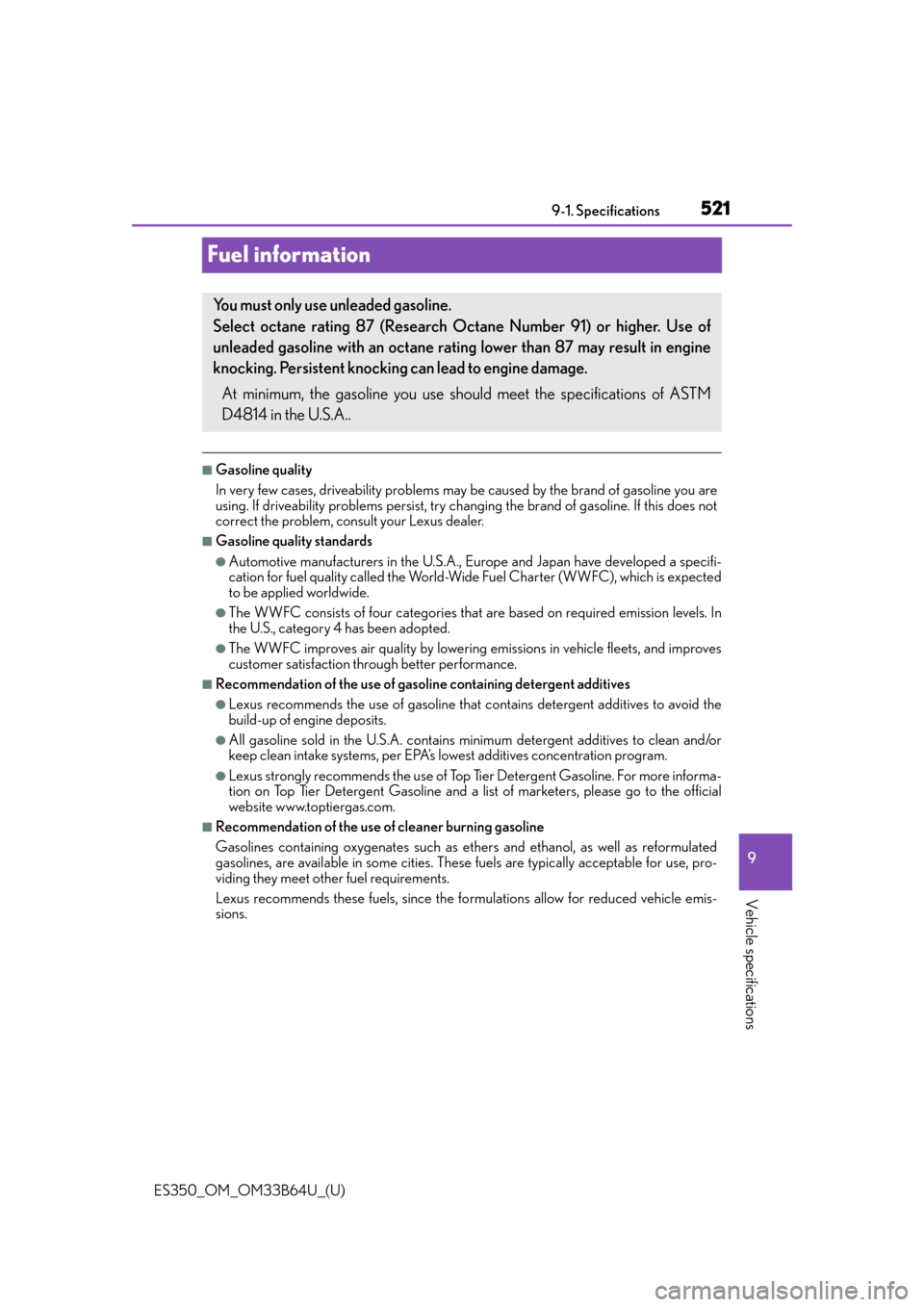
521
ES350_OM_OM33B64U_(U)9-1. Specifications
9
Vehicle specifications
Fuel information
■Gasoline quality
In very few cases, driveability problems may be caused by
the brand of gasoline you are
using. If driveability problems persist, try changing the brand of gasoline. If this does not
correct the problem, consult your Lexus dealer.
■Gasoline quality standards
●Automotive manufacturers in the U.S.A., Eu rope and Japan have developed a specifi-
cation for fuel quality called the World-Wi de Fuel Charter (WWFC), which is expected
to be applied worldwide.
●The WWFC consists of four cat egories that are based on required emission levels. In
the U.S., category 4 has been adopted.
●The WWFC improves air quality by lowering emissions in vehicle fleets, and improves
customer satisfaction through better performance.
■Recommendation of the use of gasoli ne containing detergent additives
●Lexus recommends the use of gasoline that contains detergent additives to avoid the
build-up of engine deposits.
●All gasoline sold in the U.S.A. contains minimum detergent additives to clean and/or
keep clean intake systems, per EPA’s lowest additives concentration program.
●Lexus strongly recommends the use of Top Ti er Detergent Gasoline. For more informa-
tion on Top Tier Detergent Gasoline and a list of marketers, please go to the official
website www.toptiergas.com.
■Recommendation of the use of cleaner burning gasoline
Gasolines containing oxygenates such as et hers and ethanol, as well as reformulated
gasolines, are available in some cities. These fuels are typically acceptable for use, pro-
viding they meet other fuel requirements.
Lexus recommends these fuels, since the fo rmulations allow for reduced vehicle emis-
sions.
You must only use unleaded gasoline.
Select octane rating 87 (Research Octane Number 91) or higher. Use of
unleaded gasoline with an octane rating lower than 87 may result in engine
knocking. Persistent knocking can lead to engine damage.
At minimum, the gasoline you use should meet the specifications of ASTM
D4814 in the U.S.A..
Page 522 of 576
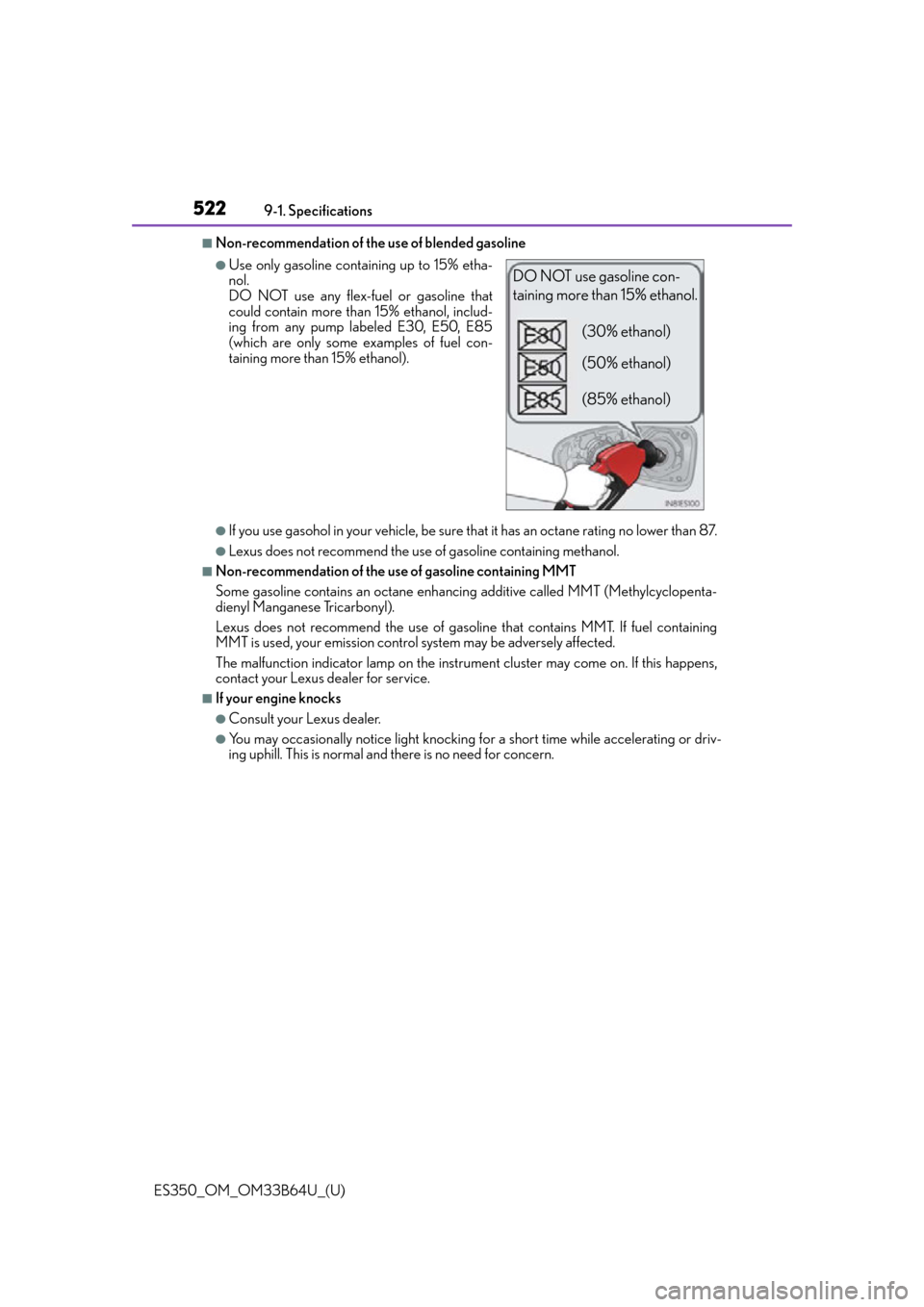
522
ES350_OM_OM33B64U_(U)9-1. Specifications
■Non-recommendation of the use of blended gasoline
●If you use gasohol in your vehicle, be sure th
at it has an octane rating no lower than 87.
●Lexus does not recommend the use of gasoline containing methanol.
■Non-recommendation of the use of gasoline containing MMT
Some gasoline contains an octane enhancin g additive called MMT (Methylcyclopenta-
dienyl Manganese Tricarbonyl).
Lexus does not recommend the use of gasolin e that contains MMT. If fuel containing
MMT is used, your emission control system may be adversely affected.
The malfunction indicator lamp on the instru ment cluster may come on. If this happens,
contact your Lexus dealer for service.
■If your engine knocks
●Consult your Lexus dealer.
●You may occasionally notice light knocking fo r a short time while accelerating or driv-
ing uphill. This is normal and there is no need for concern.
●Use only gasoline containing up to 15% etha-
nol.
DO NOT use any flex-fuel or gasoline that
could contain more than 15% ethanol, includ-
ing from any pump labeled E30, E50, E85
(which are only some examples of fuel con-
taining more than 15% ethanol).DO NOT use gasoline con-
taining more than 15% ethanol.
(30% ethanol)
(50% ethanol)
(85% ethanol)
Page 523 of 576
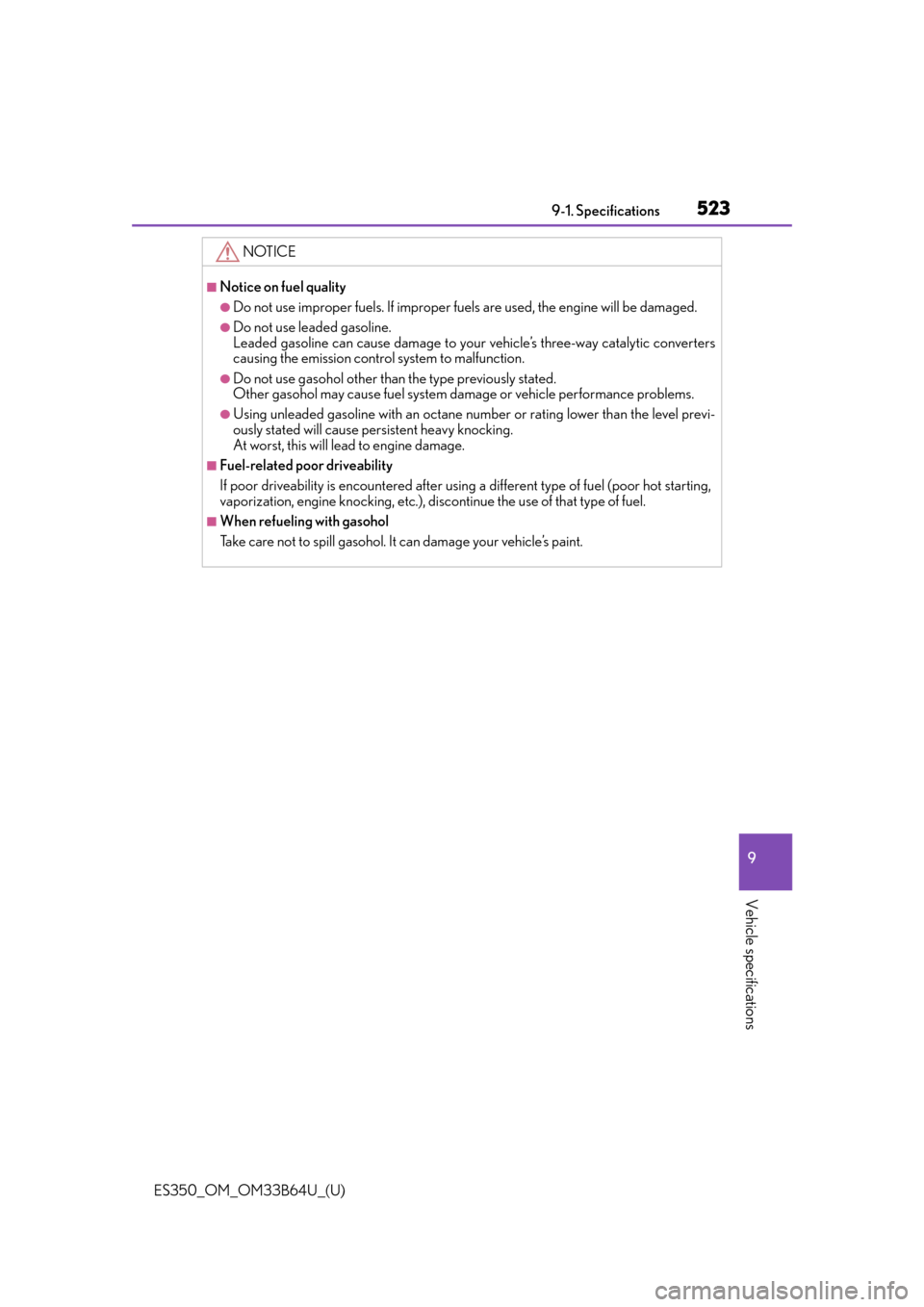
ES350_OM_OM33B64U_(U)
5239-1. Specifications
9
Vehicle specifications
NOTICE
■Notice on fuel quality
●Do not use improper fuels. If improper fuels are used, the engine will be damaged.
●Do not use leaded gasoline.
Leaded gasoline can cause damage to your vehicle’s three-way catalytic converters
causing the emission control system to malfunction.
●Do not use gasohol other than the type previously stated.
Other gasohol may cause fuel system damage or vehicle performance problems.
●Using unleaded gasoline with an octane number or rating lower than the level previ-
ously stated will cause persistent heavy knocking.
At worst, this will lead to engine damage.
■Fuel-related poor driveability
If poor driveability is encounte red after using a different type of fuel (poor hot starting,
vaporization, engine knocking, etc.), disc ontinue the use of that type of fuel.
■When refueling with gasohol
Take care not to spill gasohol. It can damage your vehicle’s paint.
Page 524 of 576
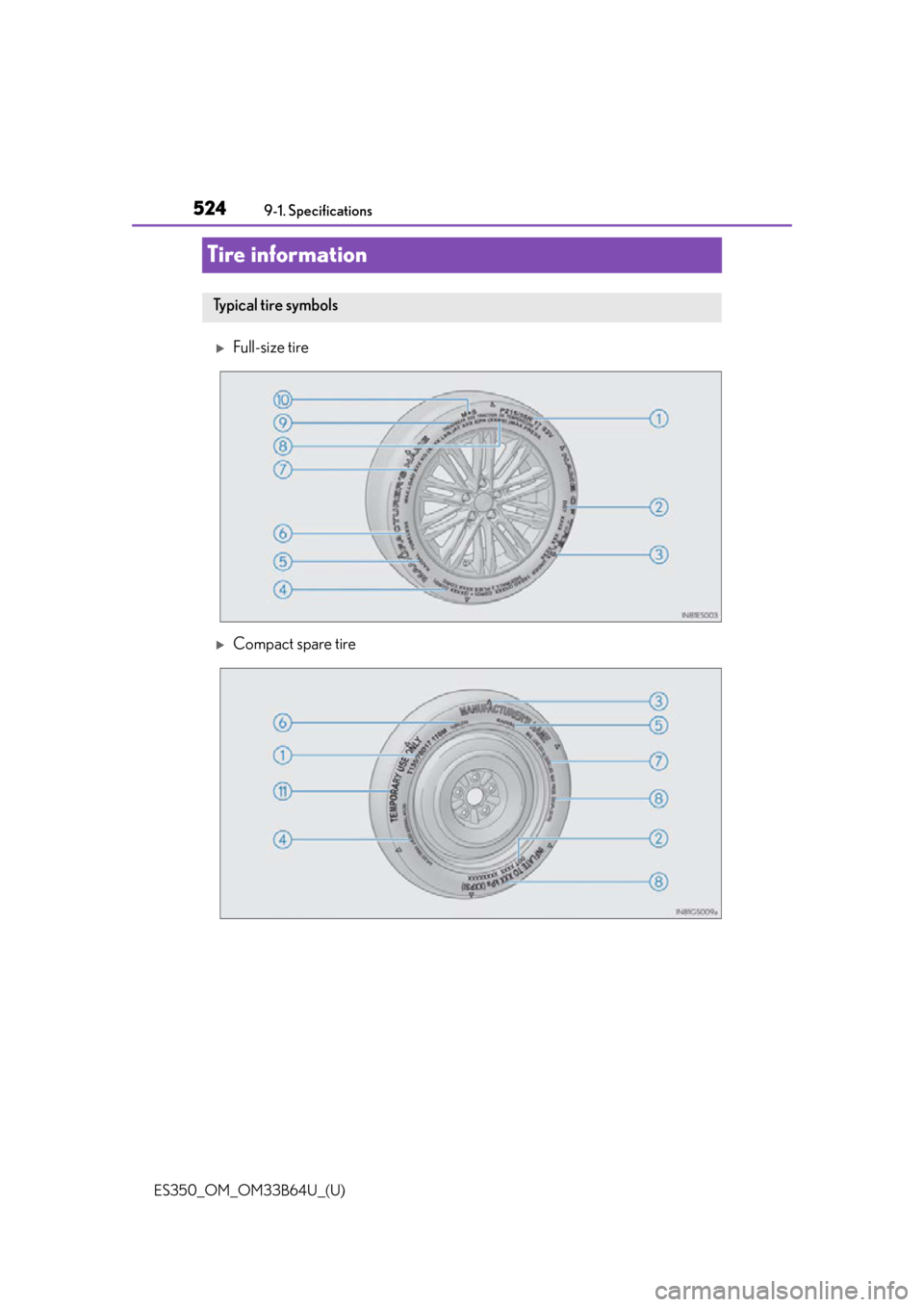
524
ES350_OM_OM33B64U_(U)9-1. Specifications
Tire information
Full-size tire
Compact spare tire
Ty p i c a l t i r e s y m b o l s
Page 525 of 576
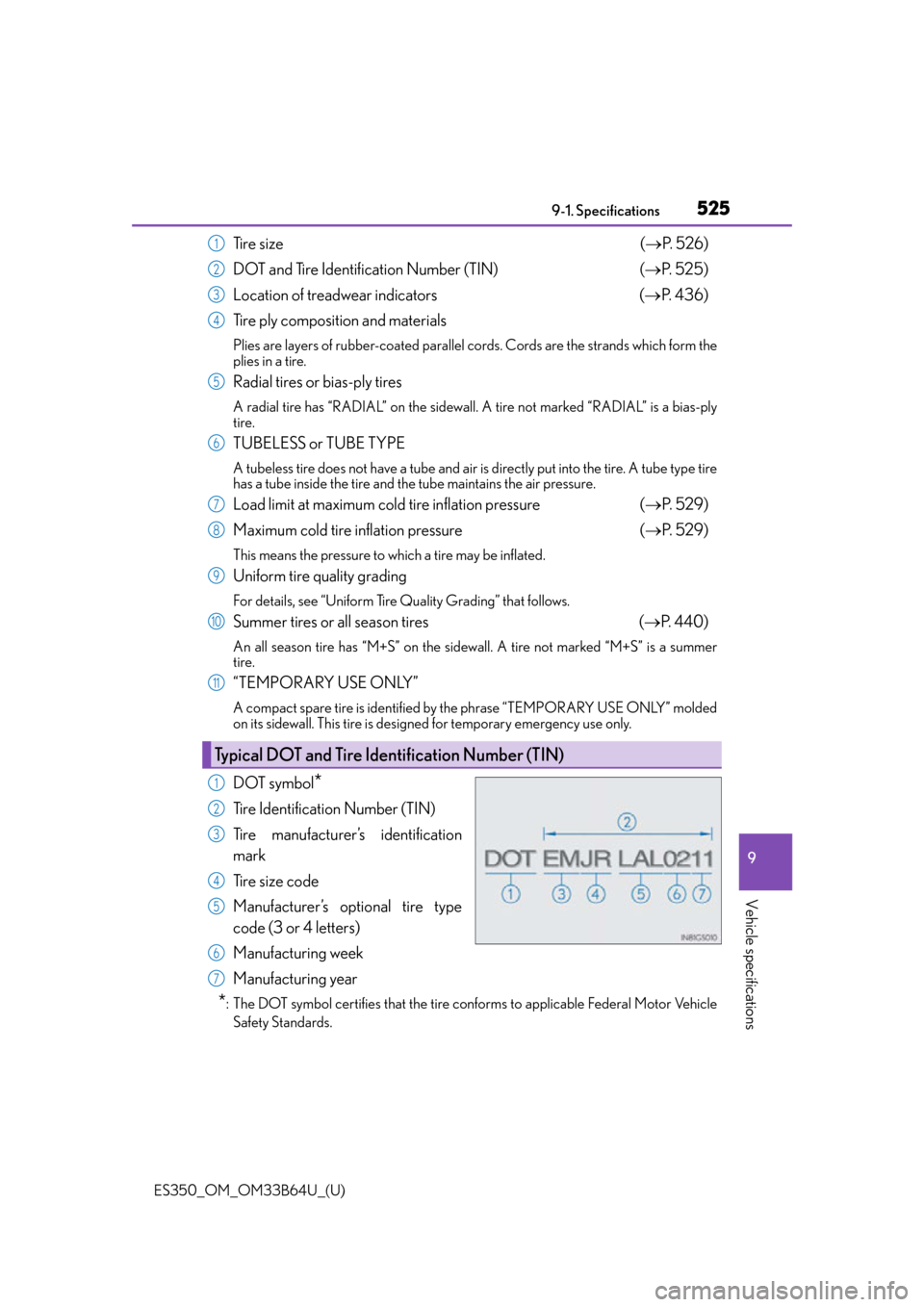
ES350_OM_OM33B64U_(U)
5259-1. Specifications
9
Vehicle specifications
Ti r e s i z e ( P. 5 2 6 )
DOT and Tire Identification Number (TIN) ( P. 5 2 5 )
Location of treadwear indicators (P. 4 3 6 )
Tire ply composition and materials
Plies are layers of rubber-coated parallel co rds. Cords are the strands which form the
plies in a tire.
Radial tires or bias-ply tires
A radial tire has “RADIAL” on the sidewall. A tire not marked “RADIAL” is a bias-ply
tire.
TUBELESS or TUBE TYPE
A tubeless tire does not have a tube and air is directly put into the tire. A tube type tire
has a tube inside the tire and the tube maintains the air pressure.
Load limit at maximum cold tire inflation pressure ( P. 5 2 9 )
Maximum cold tire inflation pressure ( P. 5 2 9 )
This means the pressure to which a tire may be inflated.
Uniform tire quality grading
For details, see “Uniform Tire Quality Grading” that follows.
Summer tires or all season tires ( P. 4 4 0 )
An all season tire has “M+S” on the sidewall. A tire not marked “M+S” is a summer
tire.
“TEMPORARY USE ONLY”
A compact spare tire is identified by the phrase “TEMPORARY USE ONLY” molded
on its sidewall. This tire is design ed for temporary emergency use only.
DOT symbol*
Tire Identification Number (TIN)
Tire manufacturer’s identification
mark
Ti r e s i z e c o d e
Manufacturer’s optional tire type
code (3 or 4 letters)
Manufacturing week
Manufacturing year
*: The DOT symbol certifies that the tire co nforms to applicable Federal Motor Vehicle
Safety Standards.
Typical DOT and Tire Identification Number (TIN)
1
2
3
4
5
6
7
8
9
10
11
1
2
3
4
5
6
7
Page 526 of 576
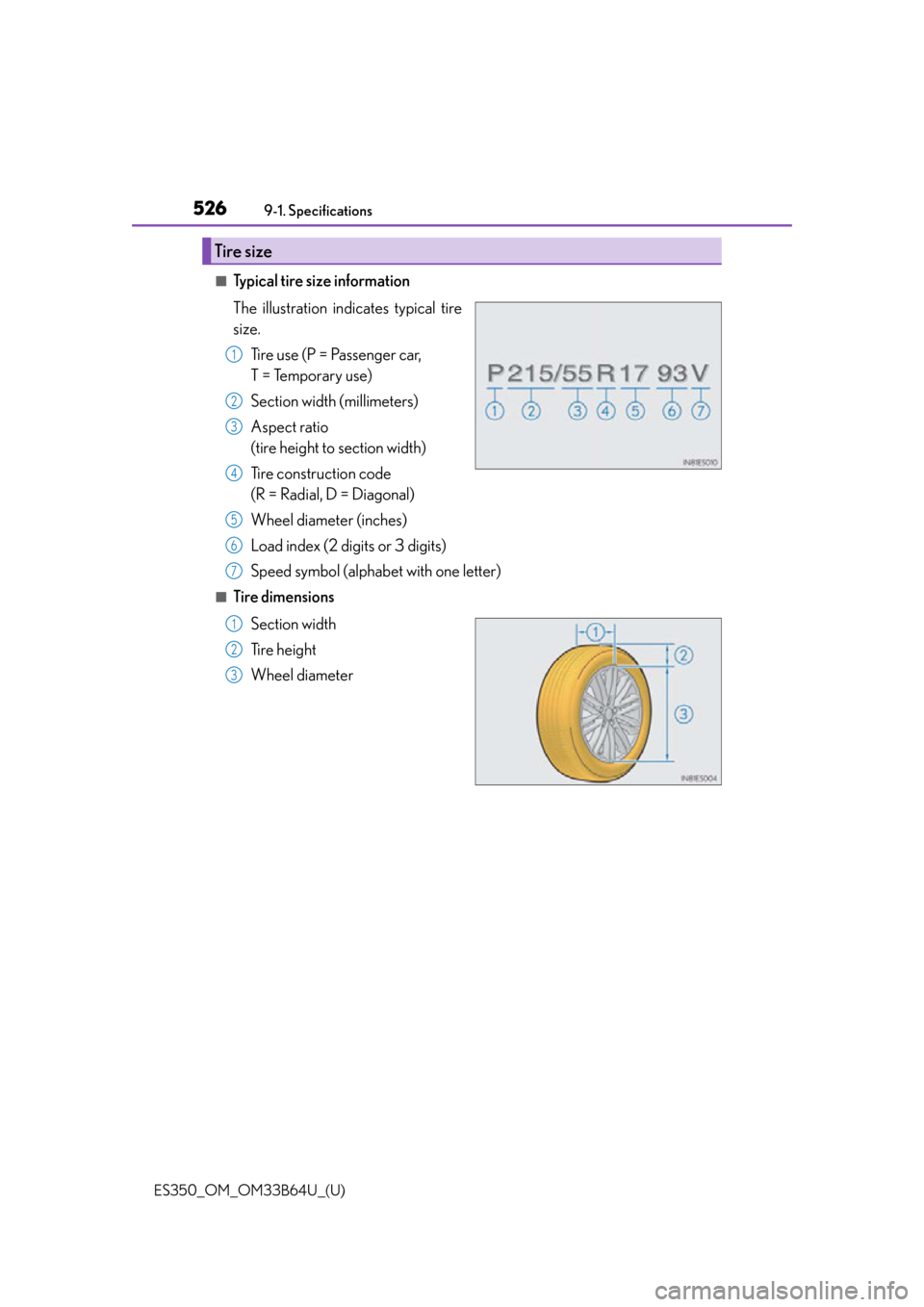
526
ES350_OM_OM33B64U_(U)9-1. Specifications
■Typical tire size information
The illustration indicates typical tire
size.
Tire use (P = Passenger car,
T = Temporary use)
Section width (millimeters)
Aspect ratio
(tire height to section width)
Tire construction code
(R = Radial, D = Diagonal)
Wheel diameter (inches)
Load index (2 digits or 3 digits)
Speed symbol (alphabet with one letter)
■Tire dimensions
Section width
Tire height
Wheel diameter
Tire size
1
2
3
4
5
6
7
1
2
3
Page 527 of 576
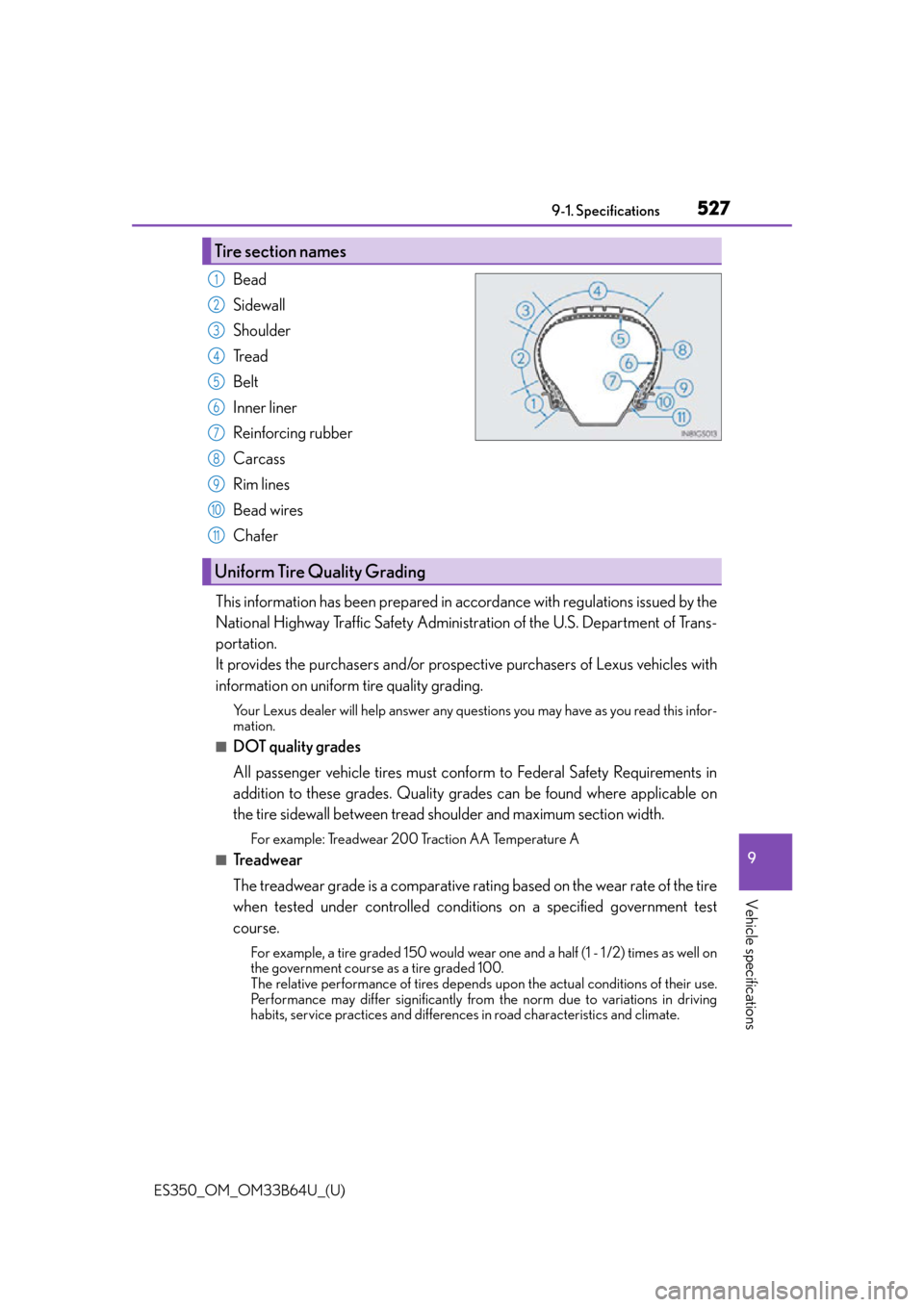
ES350_OM_OM33B64U_(U)
5279-1. Specifications
9
Vehicle specifications
Bead
Sidewall
Shoulder
Tr e a d
Belt
Inner liner
Reinforcing rubber
Carcass
Rim lines
Bead wires
Chafer
This information has been prepared in acco rdance with regulations issued by the
National Highway Traffic Safety Administration of the U.S. Department of Trans-
portation.
It provides the purchasers and/or prospective purchasers of Lexus vehicles with
information on uniform tire quality grading.
Your Lexus dealer will help answer any questions you may have as you read this infor-
mation.
■DOT quality grades
All passenger vehicle tires must conform to Federal Safety Requirements in
addition to these grades. Quality grad es can be found where applicable on
the tire sidewall between tread shoulder and maximum section width.
For example: Treadwear 200 Traction AA Temperature A
■Tr e a d w e a r
The treadwear grade is a comparative rati ng based on the wear rate of the tire
when tested under controlled conditions on a specified government test
course.
For example, a tire graded 150 would wear one and a half (1 - 1 /2) times as well on
the government course as a tire graded 100.
The relative performance of tires depends upon the actual conditions of their use.
Performance may differ significantly from the norm due to variations in driving
habits, service practices and differences in road characteristics and climate.
Tire section names
1
2
3
4
5
6
7
Uniform Tire Quality Grading
8
9
10
11
Page 528 of 576

528
ES350_OM_OM33B64U_(U)9-1. Specifications
■Tr a c t i o n A A , A , B , C
The traction grades, from highest to lowest, are AA, A, B and C, and they rep-
resent the tire’s ability to stop on we
t pavement as measured under controlled
conditions on specified government te st surfaces of asphalt and concrete.
A tire marked C may have poor traction performance.
Warning: The traction grade assigned to this tire is based on braking (straight
ahead) traction tests and does not include cornering (turning) traction.
■Temperature A, B, C
The temperature grades are A (the highes t), B, and C, representing the tire’s
resistance to the generation of heat and its ability to dissipate heat when
tested under controlled conditions on a specified indoor laboratory test
wheel.
Sustained high temperature can cause the material of the tire to degenerate and
reduce tire life, and excessive temperature can lead to sudden tire failure.
Grade C corresponds to a level of perfor mance which all passenger car tires must
meet under the Federal Motor Vehicle Safety Standard No. 109.
Grades B and A represent higher levels of performance on the laboratory test
wheel than the minimum required by law.
Warning: The temperature grades of a tire assume that it is properly inflated and
not overloaded.
Excessive speed, underinflation, or excessiv e loading, either separately or in com-
bination, can cause heat buildup and possible tire failure.
Page 529 of 576
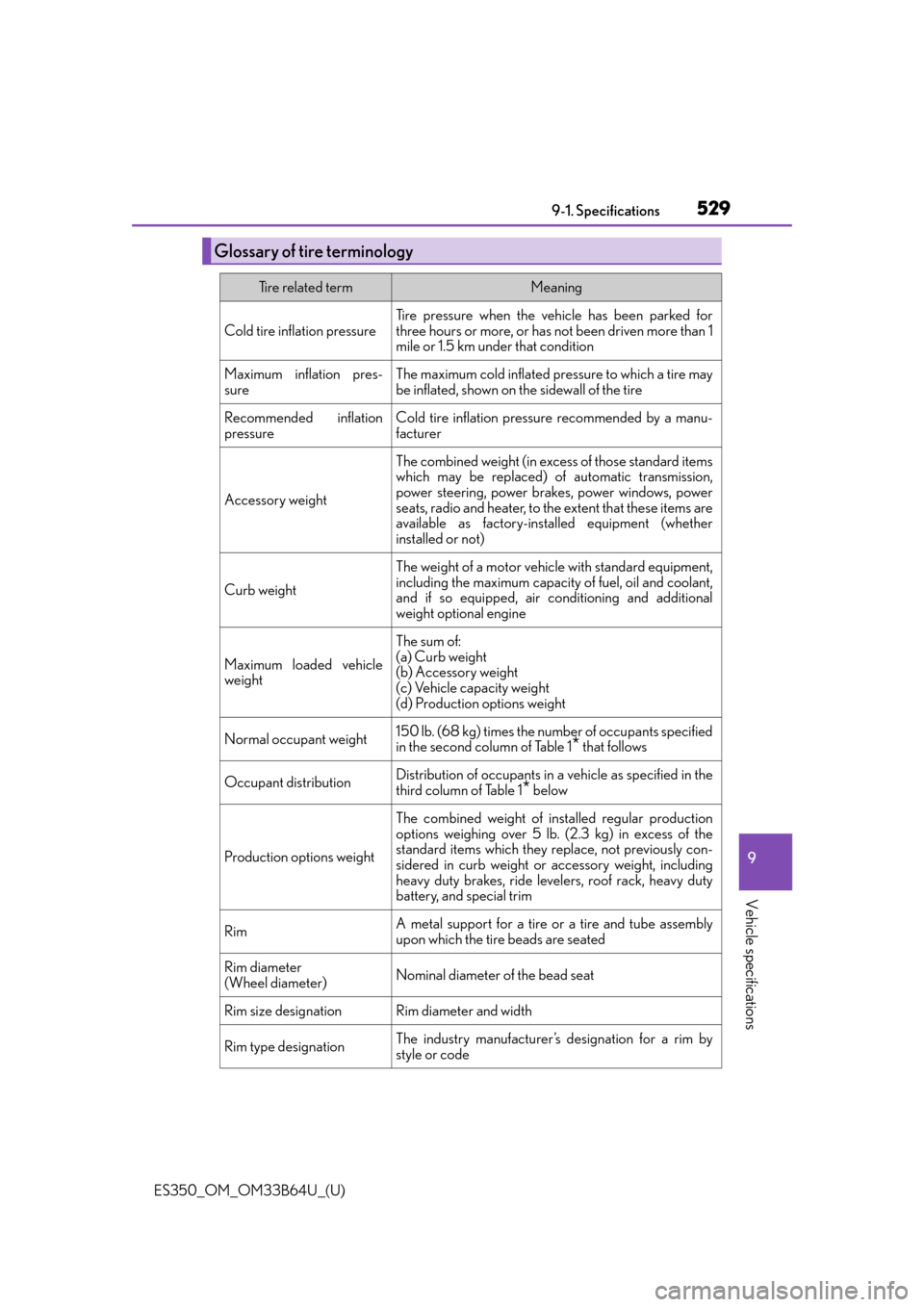
ES350_OM_OM33B64U_(U)
5299-1. Specifications
9
Vehicle specifications
Glossary of tire terminology
Tire related termMeaning
Cold tire inflation pressure
Tire pressure when the vehicle has been parked for
three hours or more, or has not been driven more than 1
mile or 1.5 km under that condition
Maximum inflation pres-
sureThe maximum cold inflated pressure to which a tire may
be inflated, shown on the sidewall of the tire
Recommended inflation
pressureCold tire inflation pressure recommended by a manu-
facturer
Accessory weight
The combined weight (in excess of those standard items
which may be replaced) of automatic transmission,
power steering, power brakes, power windows, power
seats, radio and heater, to the extent that these items are
available as factory-installed equipment (whether
installed or not)
Curb weight
The weight of a motor vehicle with standard equipment,
including the maximum capacity of fuel, oil and coolant,
and if so equipped, air co nditioning and additional
weight optional engine
Maximum loaded vehicle
weight
The sum of:
(a) Curb weight
(b) Accessory weight
(c) Vehicle capacity weight
(d) Production options weight
Normal occupant weight150 lb. (68 kg) times the numb er of occupants specified
in the second column of Table 1* that follows
Occupant distributionDistribution of occupants in a vehicle as specified in the
third column of Table 1
* below
Production options weight
The combined weight of installed regular production
options weighing over 5 lb. (2.3 kg) in excess of the
standard items which they replace, not previously con-
sidered in curb weight or accessory weight, including
heavy duty brakes, ride levelers, roof rack, heavy duty
battery, and special trim
RimA metal support for a tire or a tire and tube assembly
upon which the tire beads are seated
Rim diameter
(Wheel diameter)Nominal diameter of the bead seat
Rim size designationRim diameter and width
Rim type designationThe industry manufacturer’s designation for a rim by
style or code
Page 530 of 576
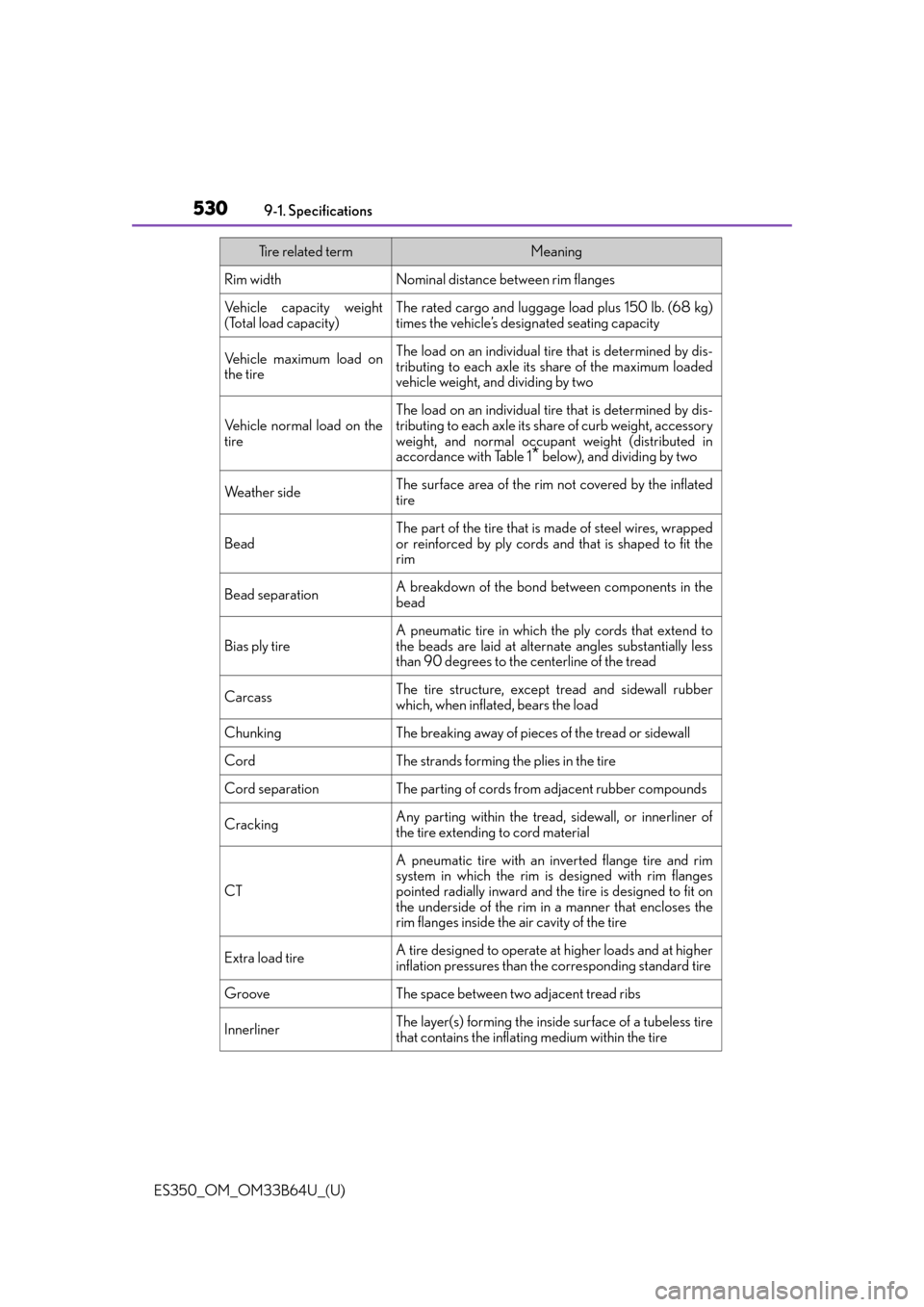
530
ES350_OM_OM33B64U_(U)9-1. Specifications
Rim widthNominal distance between rim flanges
Vehicle capacity weight
(Total load capacity)The rated cargo and luggage load plus 150 lb. (68 kg)
times the vehicle’s designated seating capacity
Vehicle maximum load on
the tireThe load on an individual tire
that is determined by dis-
tributing to each axle its share of the maximum loaded
vehicle weight, and dividing by two
Vehicle normal load on the
tireThe load on an individual tire that is determined by dis-
tributing to each axle its sh are of curb weight, accessory
weight, and normal occupant weight (distributed in
accordance with Table 1
* below), and dividing by two
We a t h e r s i d eThe surface area of the rim not covered by the inflated
tire
Bead
The part of the tire that is made of steel wires, wrapped
or reinforced by ply cords and that is shaped to fit the
rim
Bead separationA breakdown of the bond be tween components in the
bead
Bias ply tire
A pneumatic tire in which the ply cords that extend to
the beads are laid at altern ate angles substantially less
than 90 degrees to the centerline of the tread
CarcassThe tire structure, except tread and sidewall rubber
which, when inflated, bears the load
ChunkingThe breaking away of pieces of the tread or sidewall
CordThe strands forming th e plies in the tire
Cord separationThe parting of cords from adjacent rubber compounds
CrackingAny parting within the tread, sidewall, or innerliner of
the tire extending to cord material
CT
A pneumatic tire with an inverted flange tire and rim
system in which the rim is designed with rim flanges
pointed radially inward and the tire is designed to fit on
the underside of the rim in a manner that encloses the
rim flanges inside the air cavity of the tire
Extra load tireA tire designed to operate at higher loads and at higher
inflation pressures than the corresponding standard tire
GrooveThe space between two adjacent tread ribs
InnerlinerThe layer(s) forming the inside surface of a tubeless tire
that contains the inflating medium within the tire
Tire related termMeaning